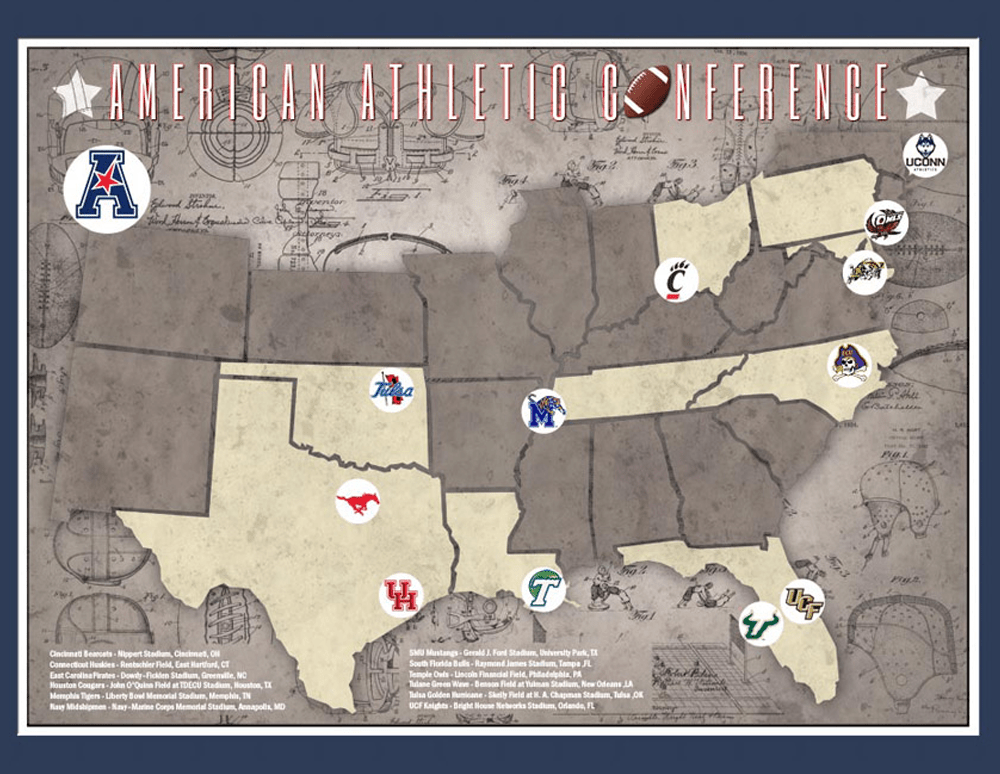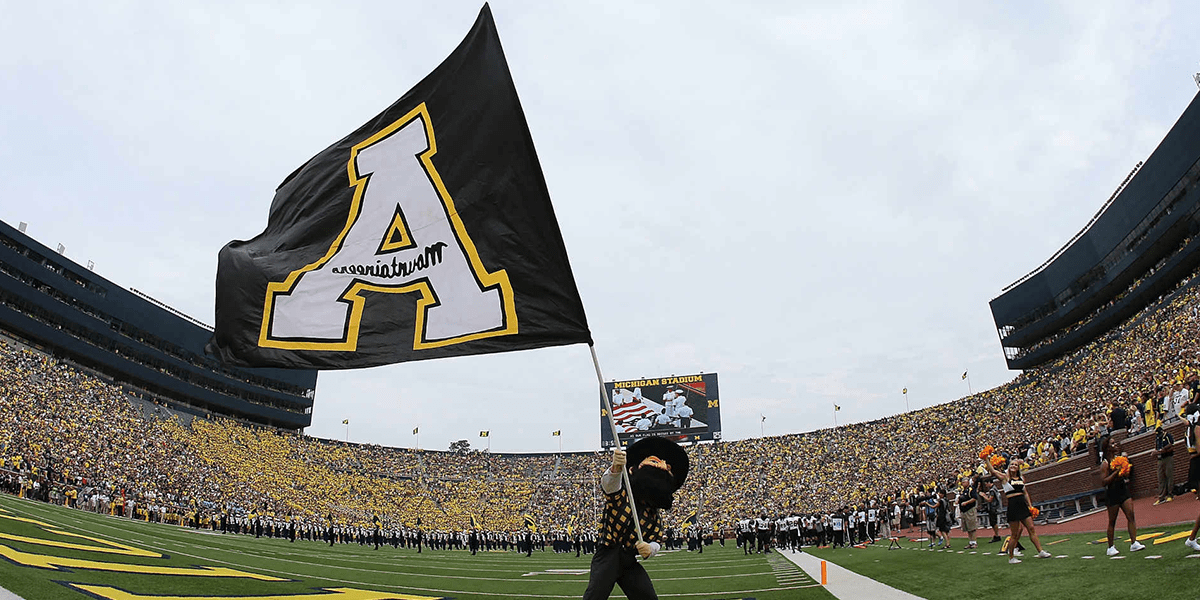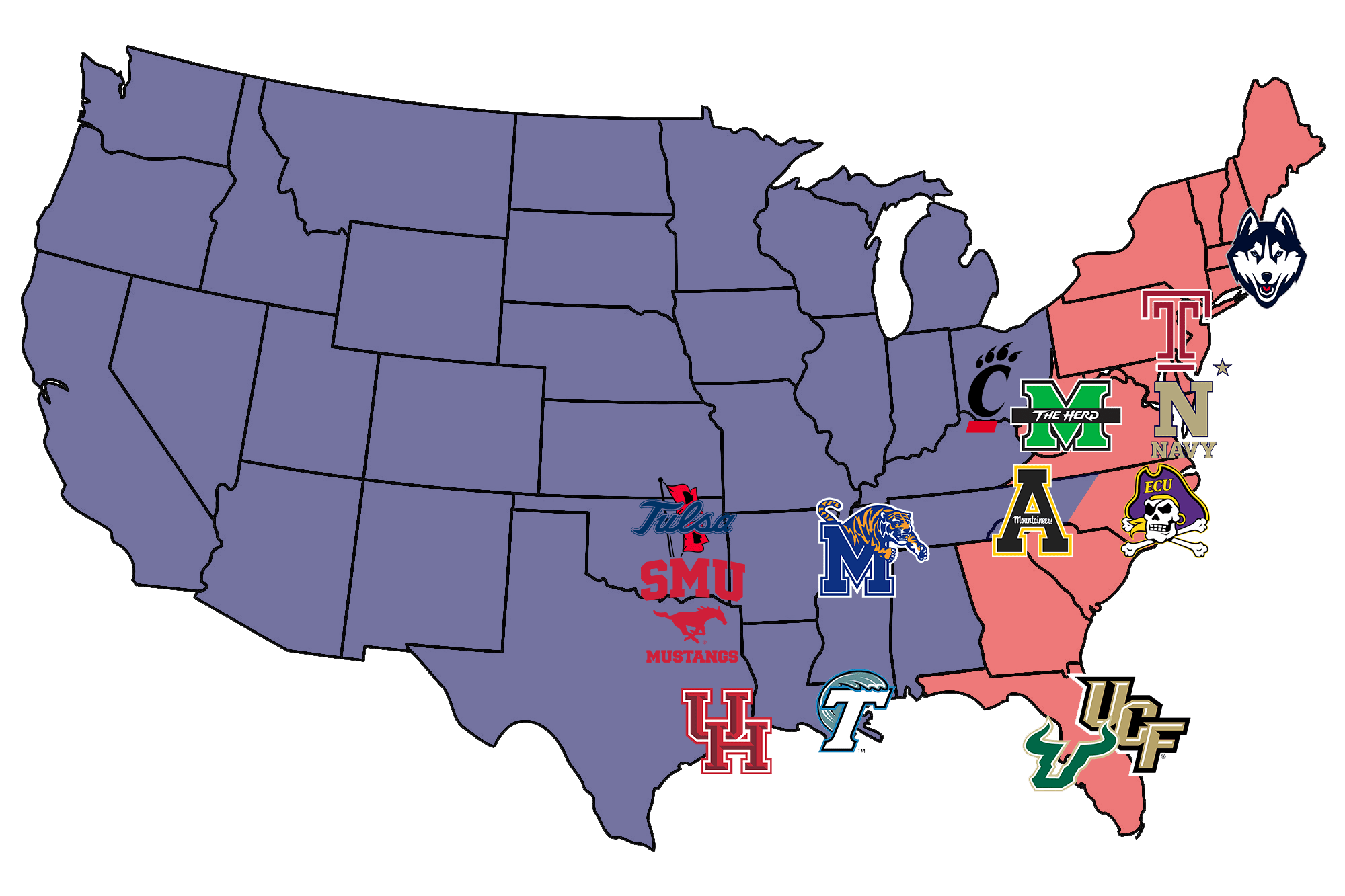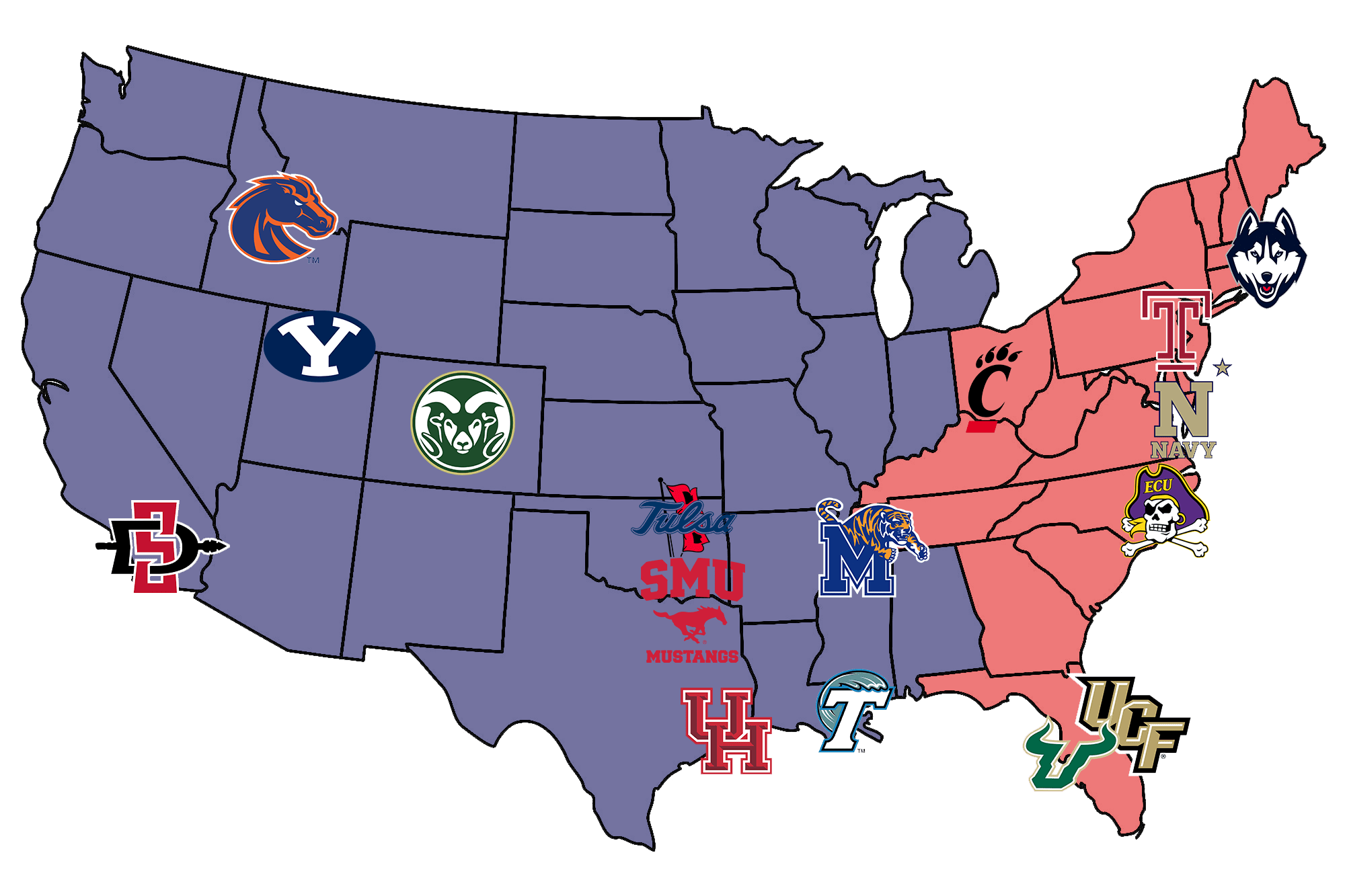The American Athletic Conference was one that was brewed out of misplacement. In the midst of the college football conference realignment era, a combination of teams from the defunct Big East and the premier programs from the C-USA chose to band together in an attempt to salvage the sixth automatic bowl bid. Long ago are the days of the six bowl-bid conferences however and similarly, the initial plan for the AAC as well.
Today, the AAC self-promotes the unofficial title of a Power 6 conference, or P6. Although it’s an extremely competitive conference, there is still plenty of push back from the P5 conferences that refuse to take the AAC seriously. Due to this fact, the AAC is one of the most expansion prone conferences. Here is a breakdown of an AAC expansion and 3 possible outcomes for the P6 status.
Current Schools

[one_half padding=”20px 20px 20px 20px”]
West
- Houston
- Memphis
- Navy
- SMU
- Tulsa
- Tulane
[/one_half][one_half_last padding=”20px 20px 20px 20px”]
East
- Cincinnati
- UConn
- ECU
- Temple
- UCF
- USF
[/one_half_last]
Original Plan
Due to the Big East being a main target during the conference realignment of 2010-2012, the conference was being slowly picked apart. In 2011, Pittsburgh and Syracuse joined the ACC and in 2012, West Virginia made the decision to join the Big 12. Although originally known for their success in basketball, these losses sparked the decision to create a more football-minded conference called the American Athletic Conference.

The plan for the AAC was to include Rutgers, Cincinnati, UConn, USF, Temple and Louisville from the Big East. It would also include seven schools from the C-USA; UCF, ECU, Houston, Memphis, SMU, Tulsa and Tulane, as well as three from the MWC; TCU, Boise State and SDSU, and one independent; Navy.
However, before the conference even began, TCU joined the Big 12 which sparked Boise State and SDSU’s decision to stay in the MWC. After only one football season, Louisville left for the ACC and Rutgers for the Big Ten. It’s a shame the original plan for the AAC didn’t workout because it would have been a spectacular conference that would easily be deserving of the P6 title. With an odd number of teams, the AAC would have had to include another school, most likely from the MWC. Below, I’ve included a breakdown of what that conference would have looked like today with the addition of Colorado State.

[one_half padding=”20px 20px 20px 20px”]
West
- Houston
- SMU
- Tulsa
- Tulane
- Memphis
- TCU
- Boise State
- SDSU
- Colorado State
[/one_half][one_half_last padding=”20px 20px 20px 20px”]
East
- Cincinnati
- UConn
- Temple
- USF
- UCF
- Rutgers
- ECU
- Navy
- Louisville
[/one_half_last]
Expansion 1: Immediately Accessible Options
The Expansion 1 option is a list of high-caliber teams from lesser conferences that would be immediately accessible if the AAC chose to expand. Although the most likely to occur, this option wouldn’t necessarily offer the AAC the best outcome for better competition. It could be argued that all of these schools have a high level of potential if competing in a more valuable and competitive conference but it would possibly be a commensalism relationship until then, rather than mutualism.

In my opinion, I wouldn’t recommend expanding the conference to include these schools. While it may seem hypocritical in an AAC article to argue against smaller football programs attempting to join a better conference in hopes to become more viable, the AAC is in no place to help promote that growth. While the P5 conferences may have that luxury, the AAC is desperately trying to earn the P6 title, so any expansion has to be one that will immediately increase the entire conference’s competitiveness.
[one_half padding=”20px 20px 20px 20px”]
C-USA
- Marshall
- Southern Miss
- Florida Atlantic
- Louisiana Tech
- North Texas
- UTSA
[/one_half][one_half_last padding=”20px 20px 20px 20px”]
Sun Belt
- App State
Independent
- Army
[/one_half_last]
My Picks: Marshall and App State.
If the AAC chose to add schools from the lesser conferences, I don’t image they would add more than two, equating a total of 14 football members. I would also move Navy to the East Division where they regionally belong and Cincinnati to the West to balance out the sides. I believe Marshall and App State would help solidify that part of the country where the AAC already has a footprint. Marshall is a successful program that has been teetering on joining the AAC for awhile and App State has the highest ceiling, in my opinion. Here’s what the conference would look like.

[one_half padding=”20px 20px 20px 20px”]
West
- Houston
- Memphis
- SMU
- Tulsa
- Tulane
- Cincinnati (East)
- App State (Sun Belt)
[/one_half][one_half_last padding=”20px 20px 20px 20px”]
East
- UConn
- ECU
- Temple
- UCF
- USF
- Navy (West)
- Marshall (C-USA)
[/one_half_last]
Expansion 2: Mountain West Merger
The only other G5 conference that has proven to able to consistently compete with P5 schools is the Mountain West Conference. Although not quite as talent ridden as the AAC, the MWC has some truly top-tier programs stuck in a G5 conference. Boise State has become a house-hold name and arguably the truest G5 blue blood program, pun not intended. San Diego State has been consistently competitive in all sports for quite some time and Colorado State just built a new football stadium that is worthy of a P5 conference.

As I previously mentioned, Boise State and SDSU were originally set to leave the MWC for the AAC but backed out of the deal when TCU left. Since then, the MWC has been stuck in an awkward position just below the AAC yet in a class above the remaining G5 conferences with some of the best G5 football teams. It feels like only a matter of time before the top MWC programs join the AAC and truly creates a P6 conference. This would be a great expansion for any team involved and is a viable option that seems like it should have happened years ago.
My Picks: Boise State, SDSU, Colorado State and BYU.
Although their are a few quality options to choose from the MWC, I feel the best picks are a no-brainer. Boise State, SDSU and Colorado state would bring not only a majority of the top competitiveness from the MWC but arguably the largest fan bases as well. Although BYU is not in the MWC, if the AAC managed to add those three top-tier G5 programs, I suspect it would give the Cougars the push they finally need to leave independence behind. With the rapid expansion of top conferences, remaining independent doesn’t appear to be a feasible long-term investment. Here’s what the AAC would look like

[one_half padding=”20px 20px 20px 20px”]
West
- Houston
- SMU
- Tulsa
- Tulane
- Boise State (MWC)
- SDSU (MWC)
- Colorado State (MWC)
- BYU (Independent)
[/one_half][one_half_last padding=”20px 20px 20px 20px”]
East
- Cincinnati
- UConn
- ECU
- Temple
- UCF
- USF
- Navy (West)
- Memphis (West)
[/one_half_last]
Expansion 3: Big 12 Dissolve – Final Solution
Expansion 3 is not only the most controversial and unlikely but also the absolute best case scenario for the AAC. That’s because it would require the Big 12 to dissolve in order to take advantage of the carnage. Although this may sound far-fetched, there is actually a fair amount of interested events to back up the claim. Firstly, after 12 G5 schools got their hopes up that they might join the Big 12, the conference chose to remain at 10 schools. Also, as of 2017 the Big 12 extender commissioner Bob Bowlsby’s contract to 2025. The reason this is interesting is because it also happens to be when the conference’s grant of rights expires.

Grant of rights are extremely important because they ensures that every team in the conference is bound by certain rules and media rights the schools grant to the conference. This assures the Big 12’s stability because even if a school decides to leave the conference, the Big 12 reserves the right to keep any money that school accumulates via TV. That is, until 2025 when the grant of rights expires as well as Bowlsby’s contract as conference commissioner. Convenient timing.
My Picks: Iowa State, Baylor, Boise State, SDSU, Colorado State and BYU.
If the Big 12 were to dissolve, almost every school in the conference would likely get acquired by the remaining P5 conferences. This immediate push of expansion would also motivate higher-tier G5 schools to band together in an attempt to remain relevant. That’s the reason I feel this situation would urge schools like Boise State, SDSU, Colorado State and BYU to join the most competitive remaining conference.
The only schools I could image being left out from the Big 12 would be Iowa State and Baylor. With those five additions, I truly believe the NCAA would be forced to recognize the AAC as a power conference. Unfortunately, I guess it wouldn’t be a P6 conference but a P5 instead. I think AAC fans are willing to allow that however.

[one_half padding=”20px 20px 20px 20px”]
West
- Houston
- SMU
- Tulsa
- Tulane
- Baylor (Big 12)
- Boise State (MWC)
- SDSU (MWC)
- Colorado State (MWC)
- BYU (Independent)
[/one_half][one_half_last padding=”20px 20px 20px 20px”]
East
- Cincinnati
- UConn
- ECU
- Temple
- UCF
- USF
- Navy (West)
- Memphis (West)
- Iowa State (Big 12)
[/one_half_last]
AAC P6 Status
Regardless of if you believe the AAC is the P6 conference they claim to be, you have to acknowledge the impressive level of competitiveness that is not seen by other G5 conferences. Even if you refuse to acknowledge the AAC on the same tier as the other P5 conferences, there seems to be a clear division between them and the remaining G5 conferences such as C-USA or the Sun Belt. If the AAC expanded however, it would be hard to argue their P6 status.






